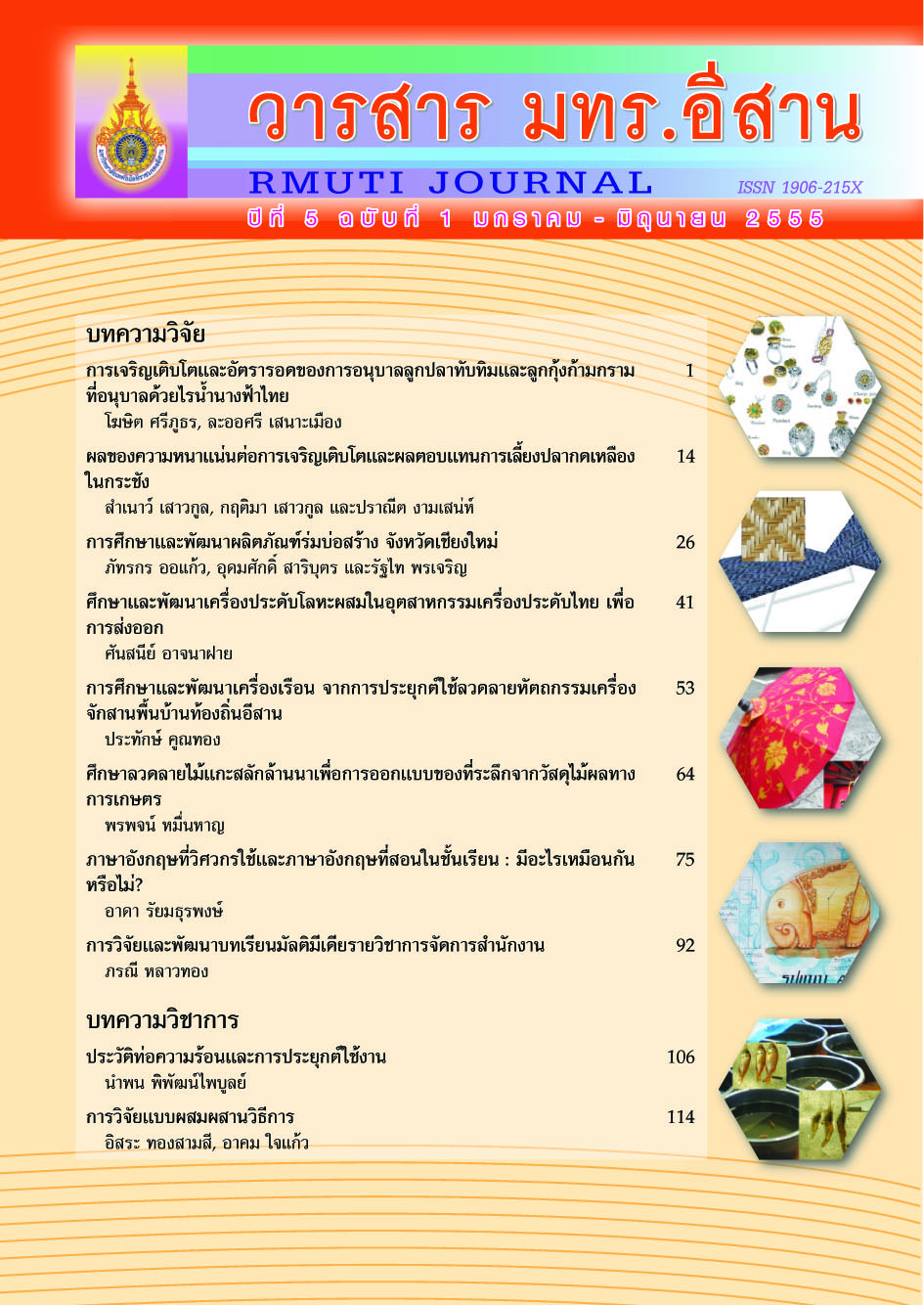การเจริญเติบโตและอัตรารอดของการอนุบาลลูกปลาทับทิมและลูกกุ้งก้ามกราม ที่อนุบาลด้วยไรนํ้านางฟ้าไทย
Main Article Content
Abstract
บทคัดย่อ
การทดลองศึกษาการเจริญเติบโตและอัตรารอดของลูกปลาทับทิม และลูกกุ้งก้ามกรามโดยใช้ลูกไรนํ้า นางฟ้าไทยเป็นอาหาร วางแผนการทดลองแบบสุ่มสมบูรณ์ สำหรับอนุบาลลูกปลาทับทิมอายุ 1 - 30 วัน และลูกกุ้งก้ามกรามอายุ 30 - 60 วัน โดยใช้อาหาร 3 สูตร ได้แก่ 1) อาหารสำเร็จรูป 40 % โปรตีน 2) ลูกไรนํ้านางฟ้าไทยอายุ 5 วัน และ 3) อาหารสำเร็จรูป ะ ลูกไรนํ้านางฟ้าไทย (50 ะ 50%) ทำการทดลอง เป็นเวลา 30 วัน ในถังพลาสติกบรรจุนํ้าประปาปราศจากคลอรีน 5 ลิตร จำนวน 3 ซํ้า ที่ระดับความหนาแน่น 5 ตัวต่อลิตร ผลการทดลองพบว่า ลูกปลาทับทิมที่ให้อาหาร 3 สูตร มีความยาวลำตัวเพิ่มขึ้น 0.712 ±0.024 0.630 ± 0.083 และ 0.772 ± 0.038 เซนติเมตร มีนํ้าหนักเพิ่มขึ้น 0.326 ± 0.009 0.252 ± 0.041 และ 0.412 ± 0.279 กรัม มีอัตรารอด 80.00 ± 2.00 86.60 ± 2.98 และ 83.33 ± 2.05 % มีอัตราการแลกเนื้อ 2.332 ±0.252.811 ±0.68 และ 2.288 ±0.998 และมีอัตราการเจริญเติบโตจำเพาะต่อวัน 2.521 ±0.604 2.431 ± 0.658 และ 3.112 ± 0.114 % ตามลำดับ และลูกกุ้งก้ามกรามที่ให้อาหาร 3 สูตร มีความยาว ลำตัวเพิ่มขึ้น 0.808 ± 0.057 0.742 ± 0.089 และ 0.833 ± 0.015 เซนติเมตร มีนํ้าหนักเพิ่มขึ้น 0.074 ± 0.008 0.093 ± 0.020 และ 0.150 ± 0.042 กรัม มีอัตรารอด 35.55 ± 3.55 55.55 ± 0.55 และ 48.88 ± 4.22 % มีอัตราการแลกเนื้อ 1.860 ± 0.245 1.581 ± 0.147 และ 1.466 ± 0.002 และมีอัตราการเจริญ เติบโตจำเพาะต่อวัน 7.296 ± 1.118 7.918 ± 1.302 และ 7.417 ± 0.692 ตามลำดับ ผลการทดลอง สรุปได้ว่าการอนุบาลลูกปลาทับทิมด้วยลูกไรนํ้านางฟ้า ะ อาหารสำเร็จรูป (50 ะ 50%) มีการเจริญเติบโตและ อัตราการแลกเนื้อดีที่สุด และการอนุบาลด้วยลูกไรนํ้านางฟ้าเพียงอย่างเดียว พบว่ามีอัตรารอดดีที่สุด (P > 0.05) และการอนุบาลลูกกุ้งก้ามกรามด้วยลูกไรนํ้านางฟ้า : อาหารสำเร็จรูป (50 : 50%) มีการเจริญเติบโต และอัตราการแลกเนื้อดีที่สุด และการอนุบาลด้วยลูกไรนํ้านางฟ้าเทียวอย่างเดียวมีอัตรารอดดีที่สุด (P<0.05)
คำสำคัญ : ไรนํ้านางฟ้าไทย, ปลาทับทิม, กุ้งก้ามกราม
Abstract
The experiment was to evaluate growth performance and survival of red nile tilapia (Oreochromis niloticus) and giant freshwater prawn (Macrobrachium rosenbergii) larvae fed with Thai fairy shrimp (Branchinella thailandensis Sanoamuang, Saengphan and Murugan) larvae. Completely randomized cultures of 1 - 30 days - old tilapia and 30 - 60 days - old prawn, were treated with 3 different food ratios ะ 1) dry shrimp diet, 40 % protein ; 2) 5 - days - old fairy shrimp larvae ; and 3) mixed fairy shrimp larvae and dry diet at 50 : 50 %. Experiments were conducted for 30 days in circular black plastic containers containing 5 L of dechlorinated tap water with 3 replicates. Each stocking density of fish and prawns were 5 individuals L’1. The results showed that the average gained length of the experimented tilapia larvae with 3 food formulas were 0.712 ± 0.024, 0.630 ± 0.083 and 0.772 ± 0.038 cm, the average gained weight were 0.326 ± 0.009, 0.252 ± 0.041 and 0.412 ± 0.279 g, the survival rate were 80.00 ± 2.00, 86.60 ± 2.98 and 83.33 ± 2.05 %, the food conversion ratio were 2.332 ± 0.25, 2.811 ± 0.68 and 2.288 ± 0.998 and the specific growth rate were 2.521 ± 0.604, 2.431 ± 0.658 and 3.112 ± 0.114 %, respectively. The average gained length of the experimented prawn larvae with 3 food formulas were 0.808 ± 0.057,0.742 ± 0.089 and 0.833 ± 0.015 cm, the average gained weight were 0.074 ± 0.008, 0.093 ± 0.020 and 0.150 ± 0.042 g, the survival rate were 35.55 ± 3.55, 55.55 ± 0.55 and 48.88 ± 4.22 %, the food conversion ratio were 1.860 ± 0.245,1.581 ± 0.147 and 1.466 ± 0.002 and the specific growth rate were 7.296 ± 1.118, 7.918 ± 1.302 and 7.417 ± 0.692 %, respectively. Present results indicate that the experimented tilapia larvae with mixed fairy shrimp larvae and dry diet at 50 : 50 % shows best growth performance and food conversion ratio and the nursing with pure fairy shrimp larvae shows best survival (P > 0.05). The experimented prawn larvae with mixed fairy shrimp larvae and dry diet at 50 : 50 % shows best growth performance and food conversion ratio and the nursing with pure fairy shrimp larvae shows best survival (P < 0.05).
Keyword : Branchinella thailandensis, Oreochromis niloticusMacrobrachium rosenberjii

